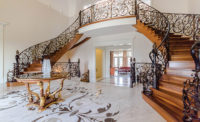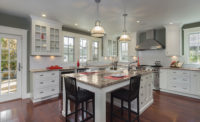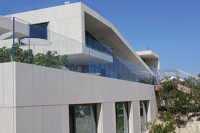| WHAT'S TRENDING |
| SELECTING THE RIGHT EDGE |
| POLISHED VERSUS HONED |
| THE FUTURE OF STONE |
What’s trending
When speaking with fabricators along the East Coast, it’s apparent that granite is not the only popular choice for countertops anymore. “Everyone wants white marble,” said Tim Farr, owner of StoneWorks in Augusta, Inc. in Augusta, GA. “It’s just really popular. We see some quartz, but for the most part, it’s everything light and white. People are moving away from the staple colors to the whites.”
Marco Duran, co-owner of Atlas Marble & Granite in Springfield, NJ, also is seeing a trend towards marble countertops. “The most popular [materials] right now are marble or quartzite,” he said. “On a scale from one to three, with one being the most popular, I’d say marble is at one, with second, being quartzite. I think marble is the most popular only because people are not really aware of quartzite.
“For example, I had a customer come in recently and said they had read about marble and peoples’ reviews about it and how to use it,” Duran explained. “And porcelain being a substitute for marble, the customer asked me the pros and cons of each. I described porcelain from a practical point of view — how it’s rigid, only has the look of marble, will chip and there’s nothing you can do to make it look original. I then explained how marble is the exact opposite of that. You can remove scratches and chips, and still have a full-body natural product. By just explaining what affects it, stains it [and things like that], they were informed enough to make a decision — not just by my opinion [or someone else’s], but by information and facts, and I found them to be a lot happier that way. Most people [just] don’t know enough.”
Farr added how he sometimes finds himself in the same situation. “Some folks come in and know what they want and some folks have no clue,” he said. “It’s all over the board.”
As an interior designer, Alena Capra, CKD, CBD of Alena Capra Designs in Fort Lauderdale, FL, said she has been working with a tremendous amount of white quartz lately. “I’ve done work in New York City as well as Florida, and more people are very much looking to do neutral quartz counters,” she said. “Quartz has been huge. A lot of white quartz is what I’m seeing. White Zeus Extreme [from Silestone] is very popular. One, it’s available in a large-format slab, so when you’re doing large kitchens with large islands, you’re able to do it. Two, it’s perfectly plain white, so it works well and allows you to do a more interesting backsplash.
“Another popular one I’m using a lot, which is traditional and contemporary, is Vanilla Ice, made by the company Pompeii Quartz,” she went on to say. “It comes in polished and honed finishes; I’ve never used honed, only the polished version. I use it a lot, and it’s nice because it looks like Carrara marble — it looks good with all-white cabinets. You’re still getting the veining, so I’m using it as a contrasting countertop. I’m definitely doing a lot of pure white and a ton of Vanilla Ice just because it works so well. Carrara marble is just too gray.”
Other popular quartz products that Capra turns to for her designs are Caesarstone’s Pebble and Cement collections and Silestone’s Platinum series. “Pebble is a softer gray color, while Cement is a nice charcoal color. They’re both very popular,” she said. “Silestone’s Platinum series is cool. There are a lot of blacks and grays, with undertones of metallic accents. You get this sparkly mirrored look. And it’s scratch-resistant, as well.”
Anna Marie Fanelli, designer and vice president of Floor & Decor in Tenafly, NJ, echoed Capra’s comments and said her clientele is also requesting a lot of quartz to use for their homes. “I’ve introduced them to Dekton [by Cosentino], an ultra-compact material composed of glass and porcelain and the highest quality quartz material that can go on the inside and outside of buildings,” she said. “It comes in monochromatic colors — blacks and different types of whites. The technology is crazy; it’s amazing. I’ve used it for fireplaces, kitchens and bathrooms.
“I rarely use granites,” Fanelli went on to say. “I either work with marbles or quartz materials — material that has one overall look. If someone wants to be environmentally friendly, IceStone will come into play — cement with recycled glass — because they have Mother of Pearl in some of their pieces. Mother of Pearl is such a big element. I do it for backsplashes in kitchens and master baths.”
Duran, on the other hand, believes that the quartz trend is contingent on the location of the fabricator or designer. “I think it’s seasonal, based on region,” he said. “There’s an ebb and flow to that. I’ve seen spikes and decreases; it has to do with the region. I always do a fair share of white quartz. I’ve seen some spikes in it. I think as you get closer to Manhattan, it leans towards the spectrum of using white. Customers in my area, there isn’t really a pattern.”
Selecting the right edge
When it comes to edges, the mitered edge has been growing in popularity, but for some areas of the country, it has already been around for a handful of years. “We took an interest in that maybe four to five years ago,” said Duran. “I just always like that look of miters and clean lines. From a personal standpoint, I want to impose that in our showroom. Pretty much, it’s more of a foresight in people’s minds. I was ahead of the trend when it came to miters in natural stone. We partook in mitering way before people took an interest in it. Now that there’s an interest in it, it’s like second nature to us. If you look at people who are trending, their choices are directed towards quartzite or stones, and those are complemented by mitered edges.”
Farr agrees that his shop is seeing more of the mitered edge. “It’s coming, I will tell you”, said Farr “If folks are not prepared, they better start to [get prepared]. [But], I think it’s just a trend. If you talk to Nick Petrona in Miami and some guys up in New York, they have been doing miters for five to six years already, and now it’s hitting other parts of the country and those two parts are leading parts of the country [when it comes to that trend]. Those guys have been saying that for years now, and they said to me, ‘You better get ready because it’s coming.’ That’s part of the reason for us buying a new CNC saw — it’s more efficient. Our old saw didn’t miter, and this one does. It makes it simple.”
Capra and Fanelli both echoed Duran and Farr’s comments, and said if not mitered, they’re seeing a lot of square edges. “Mitered with a built-up edge is very big. Everyone requests that,” said Capra. “And a square edge, if not mitered. They’re also asking for beveling, which is still popular and will be there to stay. Ogee is for more traditional spaces and mitering is for more modern and contemporary spaces.
“A waterfall edge — that is very big as well,” added Capra. “That’s for more of a table — continuation of stone and up onto counter — or for more modern kitchens on accent islands. It’s a good way to finish kitchens. It’s also a good way to bring stone in a little bit more. It’s way more durable. It’s a nice, clean, sleek look. You’ll see it a lot in magazines.”
Polished verses honed
While many people tend to veer towards a polished finish, which is highly reflective, displaying the vibrancy and character of the stone’s natural colors, it really depends on the type of material being used and its application. “If I’m working with marble, it’s most likely honed,” said Farr. “There are some people that want the polished look. I’d say it’s probably a 70 to 30 ratio. About 70% want a honed finish and 30% want a polished finish.”
Duran said most of his customers are looking for the same things. “Honing is advantageous to having marble — people will drift towards honed tops,” he said. “If it’s marble, I’m almost positive they’re going for a honed finish; there’s probably a 3-to-1 ratio they’re selecting honed over polished. The polished finish — people are going just for the look of it.”
According to Fanelli, she believes the two finishes are equally popular. “It was always honed, but now it’s 50/50,” she said. “I’ve even done polished materials in the kitchen in porcelain. Before it was honed, honed, honed. Now, it’s a combination of both.”
From Capra’s standpoint, she’s seeing the opposite, with the polished trend standing strong. “In this case, I am finding the tradition that kind of stays, for the most part, is polished countertops,” she said. “Not a lot of people are doing honed countertops. They keep trying the honed trend, but I don’t think it’s happening. A shiny piece of stone in your kitchen contrasts so nicely. Most cabinets are wood, so I think it creates a beautiful, stunning contrast to have that polished top. I really don’t get asked for honed as much as I do for polished.
“In the kitchen, I think we’re really just going for polished because it’s what works,” Capra went on to say. “We tried many other things — specialty finishes, etc. — but polished is what works. It’s what people like. That shine, balance with wood cabinet. And I kind of want them to shine — especially if I’m spending thousands of dollars on them.”
The future of stone
A couple of years ago, people were really looking for ways to save on stone products, while also being able to accomplish an upscale design. Today, the trend has totally shifted. Now, instead of worrying about cost, people are starting to indulge in the luxury items they really want, looking at it as an investment.
“The future is in semi-precious stones and the ultra-high-end market,” said Duran. “The luxury goods market is basically coming out of its shell. We’ve been predicting that for about a year now that there is a call now for a luxury product that is beyond white marble, exotic granite and engineered stone. We feel that luxury is coming back. People, again, are sort of having what they desire, instead of what is common. Granite is attainable and common — and people are looking for opulence and luxury — and that’s what is with a semi-precious collection. It’s got qualities that make it look so unique — as unique as the individual wants to be. People say, ‘This is what makes me different — having this surface. Not everyone can afford it.’ And that market is starting to bloom. It’s becoming fashionable.”
“What I’m seeing with kitchen backsplashes are a lot of stone with mirror, stone with gold, stone with platinum — a lot of mixing with exotic materials,” said Fanelli. “Backsplashes — because it’s a small space — my clients will say, ‘This is my Chanel space, where I drive my Bentley,’ so they use a mixture of Platinum with Thassos, waterjet panel with Venetian glass, just more exotic materials [overall]. White Thassos is used way more than we used before, as well as Statuary Whites and Calacatta Golds — more of the couture items used that weren’t considered as much before, but more of a staple item now because my clients are more comfortable spending now. It’s different these days; they have upscale feelings. People are saying to me, ‘The Kardashians did it,’ so you have this mindset of ‘the celebrities did it, now I can do it.’ It’s an interesting way of looking at it. If they have to spend $4,000 to $5,000, they will now. They’ll say it’s an investment; before, it was ridiculous, now it’s artwork, a specialty.”










